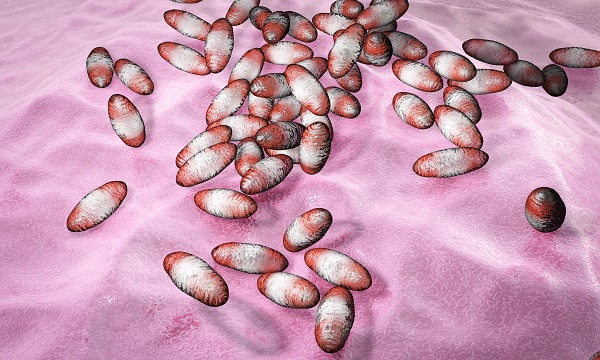
The plague's bacterial agent (pictured here) is one subject of ARUP medical director Mark Fisher's five-year National Institutes of Health grant. So is something more contemporary.
The plague—that Black Death and bacterial lurker of the Middle Ages and certain parts of the southwestern United States and Africa—provides a subject for Mark Fisher’s current National Institutes of Health (NIH) grant-funded project. That and the role of antimicrobial resistance in the disease’s transmission.
Fisher will research certain genetic mutants of the bacterial agent (Yersinia pestis, or Y. pestis) that causes the plague. These mutations are susceptible to some antimicrobial peptides (compounds consisting of two or more amino acids linked in a chain), and are also unable to maintain an infection in a flea.
Mark Fisher, PhD“We’re nearly finished with a comprehensive mutant library to look for new mechanisms of antimicrobial resistance…the mutants identified should help us understand more about how this relationship works.”
Medical Director, Bacteriology and Special Microbiology labs.
Fisher, PhD, an ARUP medical director in the Bacteriology and Special Microbiology labs, and an associate professor of pathology at the University of Utah, will continue to lead the $1.9 million study for the next four years. Here, he tells us more about that work.
-
Government funding fell below 50 percent of all scientific research funding starting in 2013, according to figures from the National Science Foundation, and is thought to be much lower than that by many scientists, so it’s especially impressive when a grant application is funded. How did you react when you received the grant?
It’s a substantial award with five years of funding, which is by no means guaranteed when you apply. The success rate is abysmally low, as you said, so anyone who gets it is excited. When you get a grant like this you have to step up and do the work you proposed—so that’s a nice impetus to do interesting research.
-
What are your hopes for the study? We hope to come away with a better understanding of what role innate antimicrobial resistance plays in both the biology and the transmission of Y. pestis. It would be nice if the lessons learned applied to other organisms that may have acquired or innate resistance, particularly against clinically available antibiotics. We’d certainly like this to help lead to strategies to avoid or overcome antibiotic resistance.

ARUP medical director Mark Fisher, PhD, is studying antimicrobial resistance's relationship to the bacterial agent of the plague on a National Institutes of Health grant. -
Can you tell me a little about the application process for the grant? My postdoc and I used the results and mutants from a career-development grant I received several years ago, combined it with relevant background, and developed the current proposal. We shared findings from current literature and included current clinical problems that we see all the time in antimicrobial resistance in other organisms, and we added in preliminary data showing a correlation between antimicrobial resistance and survival in the flea, as the basis for our proposal. The goal with any application is to design experiments to answer the major questions, and make sure those will be done in a rigorous way that provides meaningful results. Then you hope the reviewers appreciate the importance.
-
Do you have suggestions for others applying for research grants?
I don’t know that I have any recommendations for anybody. I submitted two additional grant proposals before I knew this one was funded, but neither of those received funding. So I certainly don’t have the magic touch. There is a recent emphasis on antimicrobial- resistance research at the NIH, so I think it was a good time to propose something of this kind.
-
Anything you can say about what you’ve learned so far?
We are currently building the tools necessary to answer the bigger questions proposed in the grant. In the next several months, we should have most of those tools built and can start answering more questions. We’re nearly finished with a comprehensive mutant library we can use to look for new mechanisms of antimicrobial resistance. This is one of the main tools; we plan to use it for a number of approaches to find the role antimicrobial resistance plays in plague transmission, but also in the biology of Y. pestis. The mutants identified should help us understand more about how this relationship works.
Catherine Arnold, Science Communications Writer
Related blog
"New Technology Diagnoses Pneumonia Caused by Previously Undetected Pathogens"
















